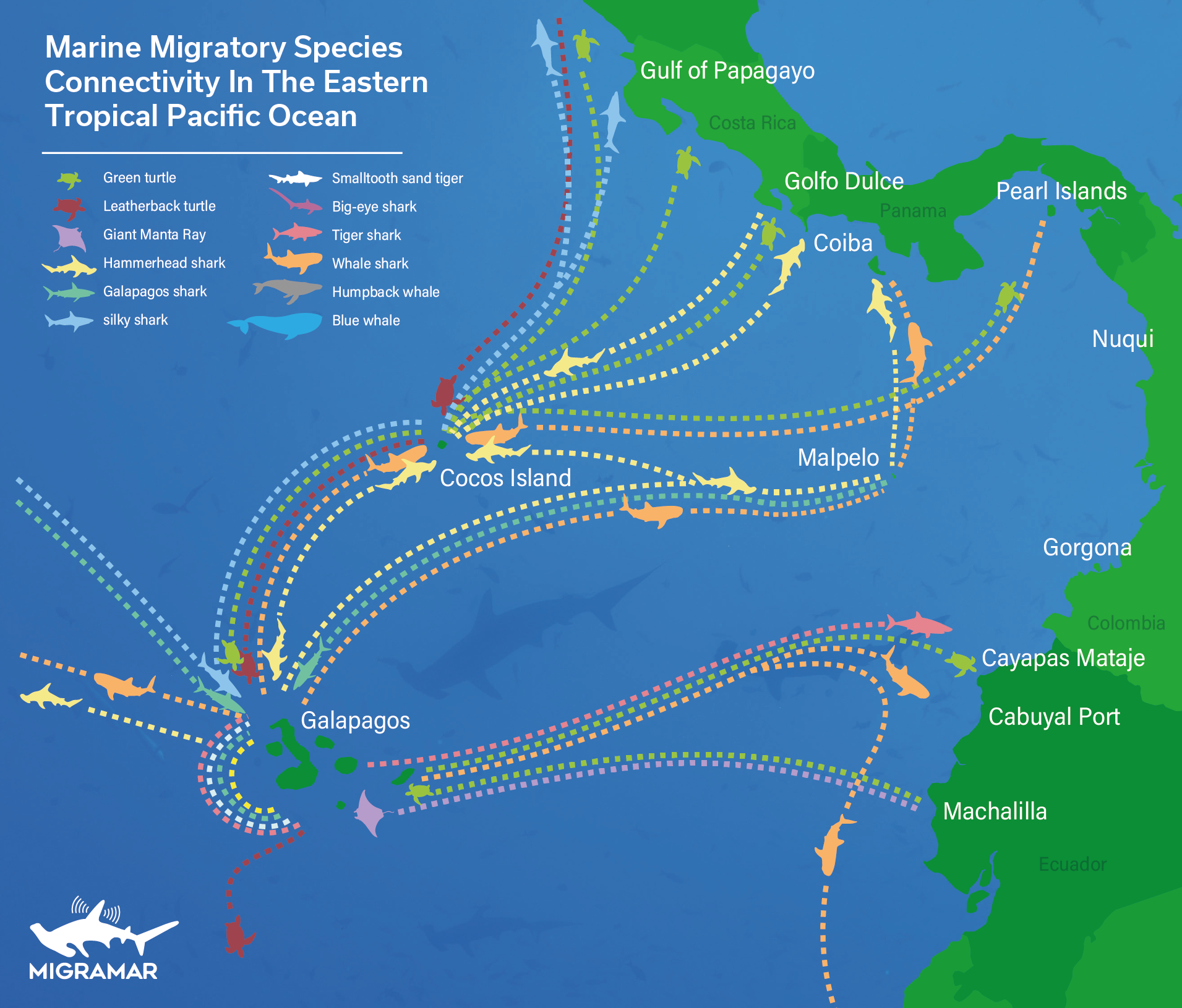For Immediate Release, August 28, 2020
Contact:
Brett Loveman, Mission Blue, bloveman@missionblue.org
Todd Steiner, Turtle Island Restoration Network, tsteiner@seaturtles.org
Environmental Groups Urge Costa Rica and Ecuador to Create World’s First Bilateral Marine Protected Area
ECUADOR — Environmental groups Mission Blue and Turtle Island Restoration Network called on the Ministers of Environment of Costa Rica and Ecuador today to move forward in creating one of the world’s first marine protected areas connecting the UNESCO biosphere reserves of two countries.
The letter urges that Costa Rica and Ecuador act quickly to create the Cocos-Galapagos Swimway, a 240,000 square-kilometer underwater highway that connects the National Parks of two sovereign nations — Costa Rica’s Cocos Island National Park with Ecuador’s Galapagos Marine Reserve — both of which are UNESCO World Heritage Sites. Scientific research in the Eastern Tropical Pacific conducted by a network of organizations known as MigraMar revealed endangered and threatened marine species like whale sharks, green sea turtles, leatherback sea turtles, silky sharks, and scalloped hammerhead sharks use this swimway to migrate between the marine reserves. When these species leave the protected areas, however, they enter the open ocean where they are at grave risk to industrial fishing.
“It’s important to think like the sharks, the sea turtles and the various forms of life that are not just found in places where we’ve named and claimed territory,” said Dr. Sylvia Earle, Founder of Mission Blue. “We must consider the creatures that occupy this liquid space that we call the ocean and realize that if we were to take action to protect them, it’s not good enough that Cocos and Galapagos have an area of a safe haven around them. What about the space in between? That has to be protected too.”
Cocos Island National Park and the Galapagos Marine Reserve not only share an important percentage of species and ecological characteristics, they also face similar threats. Both marine protected areas have regulations that control how people and commerce can interact with the islands. Despite these restrictions, conservationists face several challenges to protect the species that inhabit them.
A biological justification for the creation of the swimway recently published by MigraMar states about 19% of rays, 34% of sharks, 17% of marine mammals and 27% of marine birds found in these protected areas are threatened or endangered. The document also highlights that Cocos and Galapagos share an important percentage of endemic and island species, as well as pelagic and benthic fauna. Both sites are interconnected by the Cocos seamount ridge that concentrate a significant marine migratory activity.
“The Swimway advances our thinking about how to protect highly endangered migratory species which do not stay put in a single locale like the Galapagos or Cocos marine reserves,” said Todd Steiner, Executive Director of Turtle Island Restoration Network. “By expanding these marine protected areas and actively working with the governments of Costa Rica and Ecuador along with several additional partners to create the first bilateral agreement, we will allow endangered species to migrate safely outside the small marine protected areas and connect two sovereign nation’s marine National Parks, something we hope will be a blueprint that is copied across the globe.”
In May the Swimway was declared a Hope Spot by Mission Blue, highlighting the need for cutting-edge solutions to protect highly migratory species like sea turtles and sharks in the Eastern Tropical Pacific.
About Mission Blue
Led by legendary oceanographer Dr. Sylvia Earle, Mission Blue is uniting a global coalition to inspire an upwelling of public awareness, access and support for a worldwide network of marine protected areas – Hope Spots. Under Dr. Earle’s leadership, the Mission Blue team implements communications campaigns that elevate Hope Spots to the world stage through documentaries, social media, traditional media and innovative tools like Google Earth. Mission Blue embarks on regular oceanic expeditions that shed light on these vital ecosystems and build support for their protection. Mission Blue also supports the work of conservation NGOs around the world that share the mission of building public support for ocean protection. The Mission Blue alliance includes more than 200 respected ocean conservation groups and like-minded organizations.
About Turtle Island Restoration Network
Turtle Island Restoration Network (TIRN) is a global conservation nonprofit and leading advocate for the world’s oceans and marine wildlife. TIRN has led more than 25 tagging expeditions to Cocos Island since 2009 to help elucidate the migratory pathways of sharks and sea turtles in the Eastern Tropical Pacific. Our work is based on science, fueled by people who care, and effective at catalyzing long-lasting positive change that protects the likes of green sea turtles, whale sharks and coho salmon. By working with people, communities, and our more than 90,000 members, we preserve and restore critical habitats like the redwood-forest creek banks of California to the biodiverse waters of Cocos Island.
About MigraMar
MigraMar was founded in 2006 as a network of scientists dedicated to research and conservation of migratory marine species in the Eastern Pacific. Their mission is to provide the necessary technical advice for the conservation of the migratory marine species in the Eastern Pacific. The network is made up of 20 researchers belonging to universities, government agencies and non-profit organizations in different parts of the American continent. MigraMar provides scientific information regarding migratory patterns of marine species, evaluates and forecasts the state of populations, in order to increase knowledge about these, understand the role they play in the ecosystem, and how best to preserve them.
###




